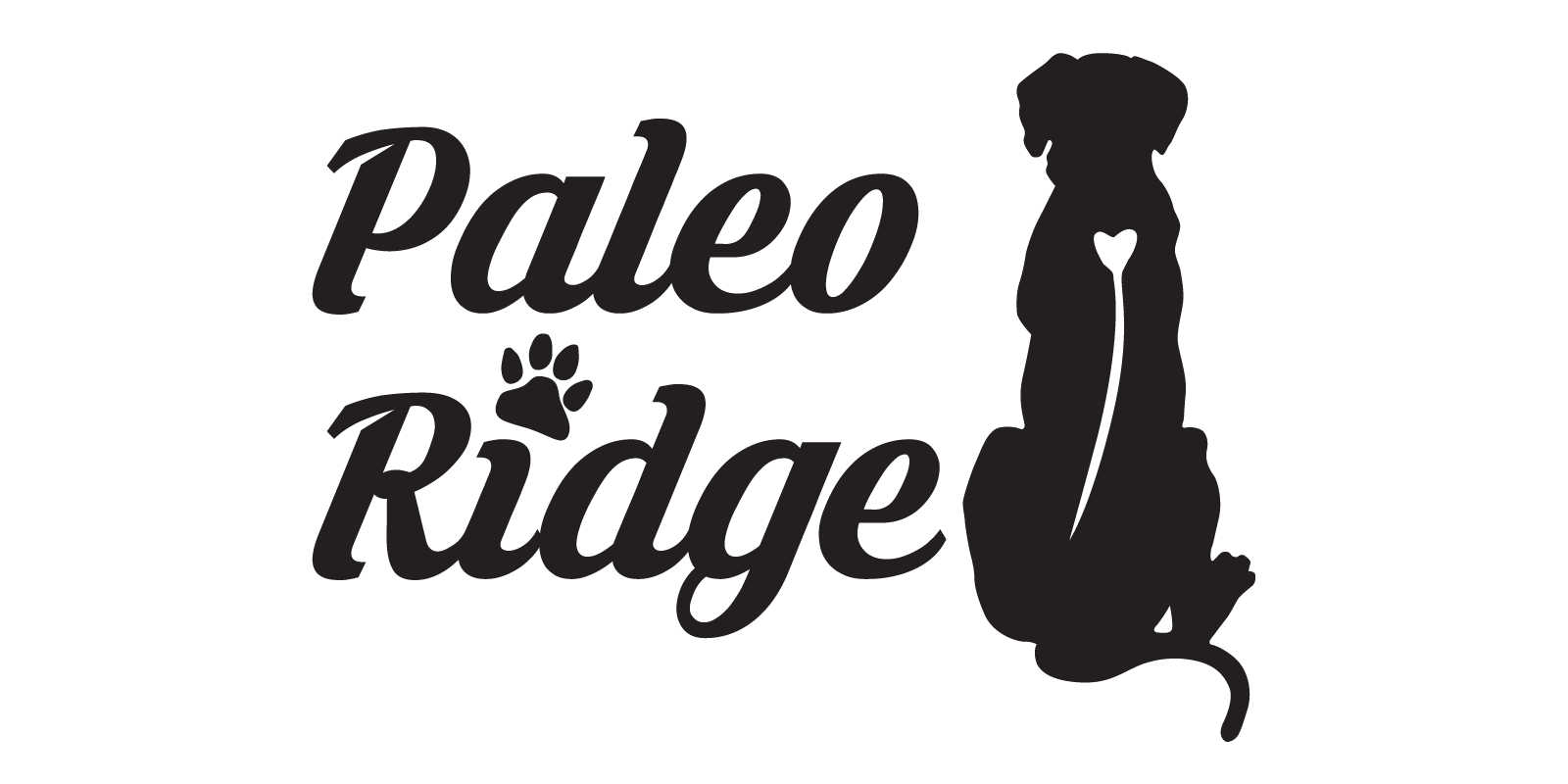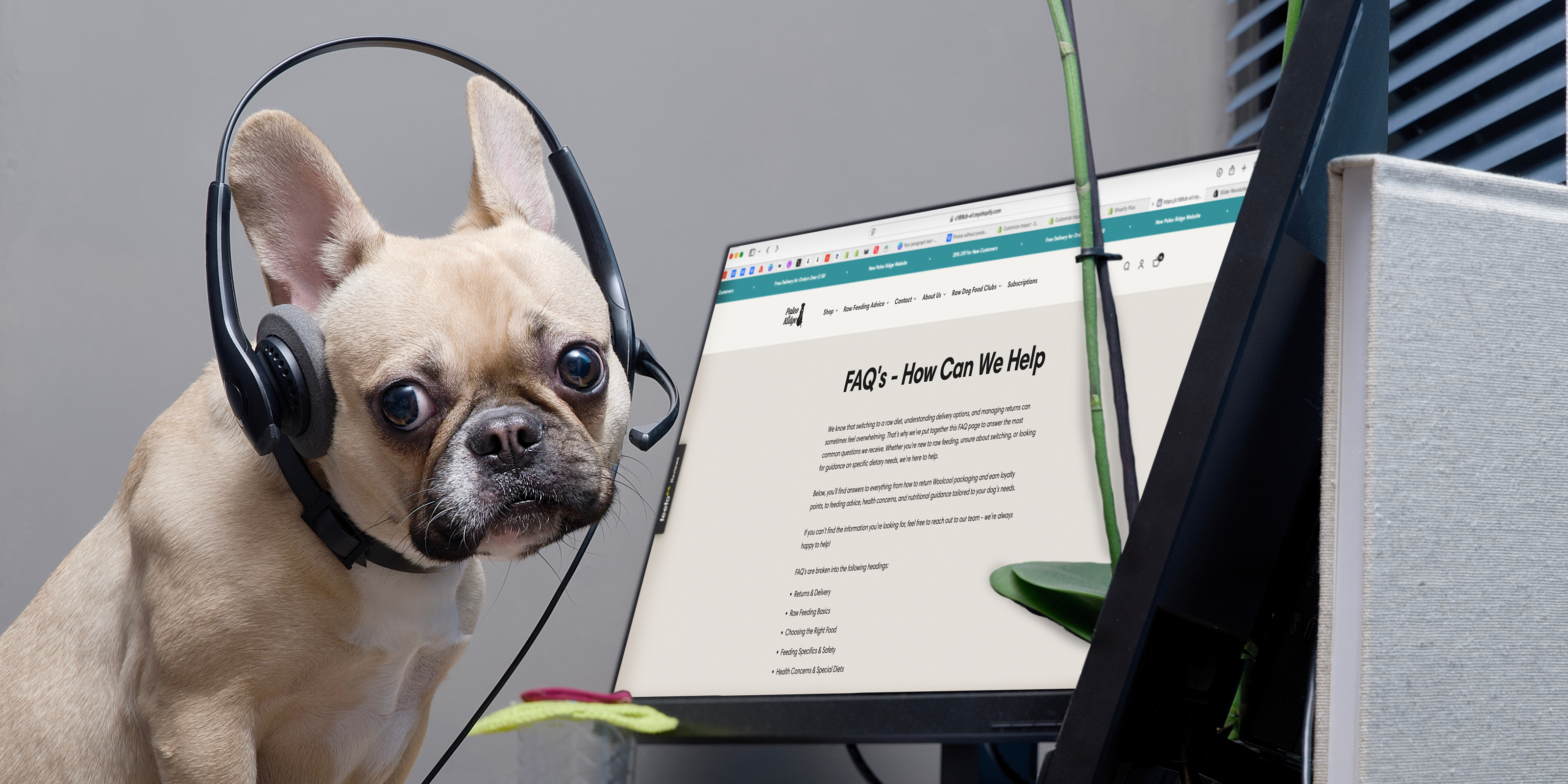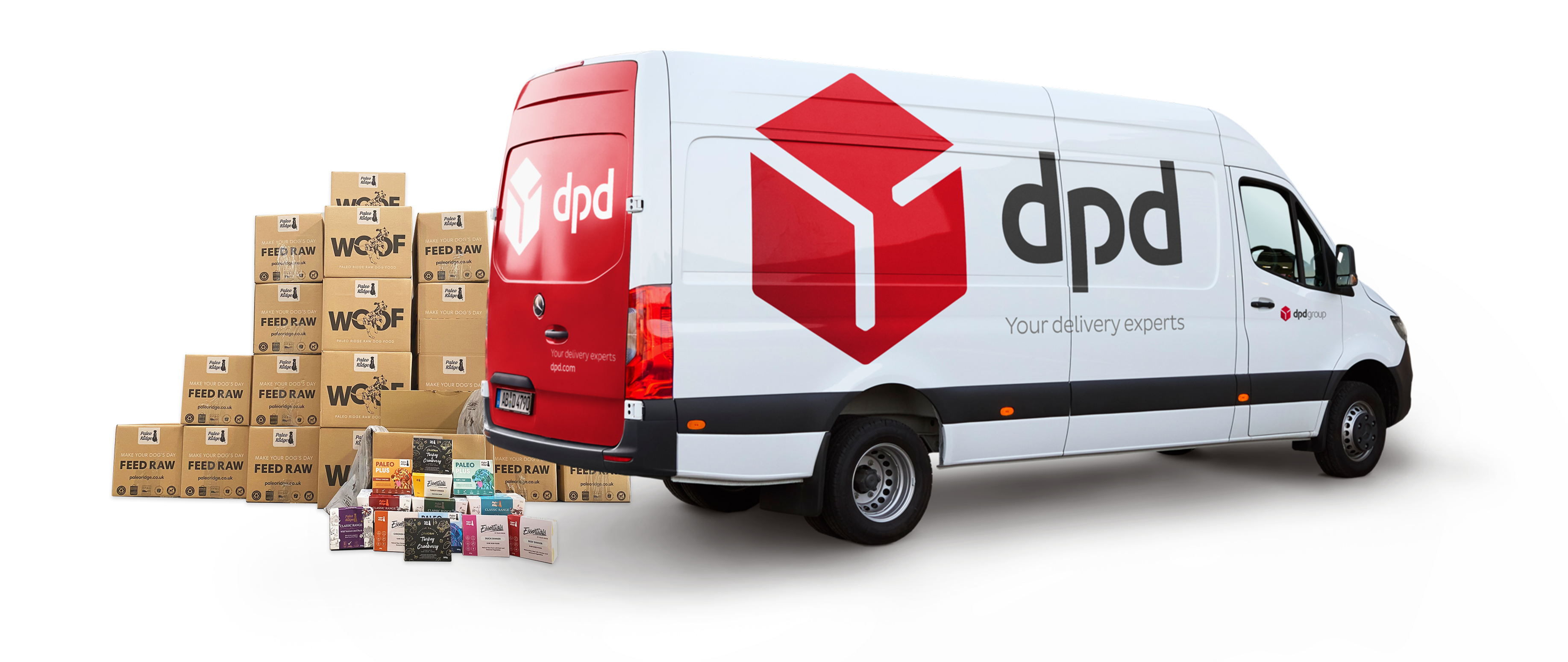FAQ's - How Can We Help
We know that switching to a raw diet, understanding delivery options, and managing returns can sometimes feel overwhelming. That’s why we’ve put together this FAQ page to answer the most common questions we receive. Whether you're new to raw feeding, unsure about switching, or looking for guidance on specific dietary needs, we’re here to help.
Below, you’ll find answers to everything from how to return Woolcool packaging and earn loyalty points, to feeding advice, health concerns, and nutritional guidance tailored to your dog’s needs.
If you can’t find the information you’re looking for, feel free to reach out to our team - we’re always happy to help!
FAQ's are broken into the following headings:
- Returns & Delivery
- Raw Feeding Basics
- Choosing the Right Food
- Feeding Specifics & Safety
- Health Concerns & Special Diets
Raw Feeding Basics
Is raw feeding safe? Could it put my family or me at risk?
When feeding raw, it’s essential to choose a manufacturer that upholds the highest standards of sourcing, handling, preparation, and storage to ensure safety and quality. We strongly recommend purchasing from reputable raw food manufacturers who can prove their standards through independent accreditations.
Before making a purchase, take the time to:
- Research the company – Look for independent feedback on platforms like Google and Feefo.
- Ask questions – Contact manufacturers directly to understand their sourcing and safety measures.
- Check for accreditations – Ensure they meet rigorous, independently verified standards.
Why Choose Paleo Ridge?
Paleo Ridge is the most accredited raw dog food manufacturer in the UK, holding multiple globally recognised, independent certifications that go far beyond the industry’s basic requirements.
Our accreditations include:
- OF&G Organic Approved
- ISO 9001 Certified
- Ethical Pet Award Approved
- DEFRA Approved (Licence No: 15/103/8003/ABP/PTF)
To maintain these certifications, we undergo regular independent audits, often unannounced, ensuring we meet the highest standards every single day. These standards far exceed basic requirements, giving you confidence in the safety and quality of every meal.
Safe Handling & Storage
For guidance on handling and storing raw dog food safely at home, please see our hygiene instructions.
Should I introduce raw food gradually or switch straight away?
We recommend making a straight switch to raw, as there’s no need for a gradual introduction. Simply choose your day and transition to a completely natural, species-appropriate diet.
However, if you prefer a slower transition, you can gradually increase raw food while reducing the old diet over 3–5 days—this approach works well for some dogs, especially those with sensitive stomachs.
There are no strict rules, so choose the method that feels right for your dog and their individual needs. The most important thing is that you’ve made the decision to switch—whether instantly or gradually, you’re making a positive change for your dog’s health.
For a step-by-step guide, read our Switch to Raw Guide
I’m new to raw feeding and feel overwhelmed—can you help?
Making the switch to raw feeding can feel overwhelming at first, but don’t worry—you’re not alone! We’re here to support you every step of the way.
To get started, take some time to explore the helpful resources on our website:
- Switch to Raw Guide – A step-by-step guide on transitioning your dog to a raw diet.
- Raw Dog Food Calculator – Easily determine the right portion sizes based on your dog’s weight, age, and activity level.
- Feeding & Storage Tips – Learn how to handle raw food safely and store it correctly.
If you have any questions or need personalised advice, please don’t hesitate to contact our team. We’re always happy to help and ensure you feel confident in making the best choice for your dog’s health and well-being.
Can I mix raw and processed food together?
We do not recommend mixing raw food with dry kibble in the same meal. Raw feeding provides the most benefits when fed exclusively, allowing your dog to fully experience its natural, species-appropriate nutrition.
If you choose to continue feeding dry food alongside raw, we advise feeding them at separate mealtimes rather than combining them in one bowl. This is because raw and processed foods digest at different rates, which can sometimes lead to stomach discomfort or digestive issues.
By mixing the two, you may also dilute the benefits of raw feeding. Kibble is a highly processed food, whereas raw is a nutrient-rich, natural diet designed for optimal canine health. For the best results, we recommend committing fully to raw feeding.
For more guidance, check out our Switch to Raw Guide or contact our team—we’re happy to help!
How often should I feed my dog each day?
There is no single "right" answer—it depends on what works best for you and your dog. If your dog is already fed twice a day, you can continue with that routine. If you prefer to feed once a day, that’s fine too. The key is consistency and ensuring your dog receives the correct daily portion.
However, different life stages may require adjustments:
- Puppies – Need to be fed more frequently to support growth and development. Read more in our Raw Feeding for Puppies Guide.
- Senior Dogs – Some older dogs may need less food if they are less active, while others may require more frequent meals as their digestive system slows and becomes less efficient at absorbing nutrients. Learn more in our Raw Feeding for Senior Dogs Guide.
If you’re unsure about the best feeding schedule for your dog, feel free to contact us for tailored advice!
Choosing the Right Food
How do I choose the right meals for my dog?
A balanced and nutritious raw diet should include plenty of variety to ensure your dog gets a full range of essential nutrients. We recommend feeding at least 5–6 different protein sources over a two-month period. This could include lamb, beef, duck, chicken, pork, venison, turkey, and more.
Why Variety Matters
Each protein source offers a unique nutritional profile, so the more variety your dog eats, the more complete their diet will be. Feeding different meats helps provide a balance of amino acids, vitamins, and minerals to support your dog’s overall health.
Choosing the Right Meals
We offer a range of complete and balanced raw meals, making it easy to provide variety:
- Classic Range 80-10-10 Meals – Available in 1kg, 500g and 250g packs, these meals follow the ideal 80% meat, 10% bone, 10% offal ratio.
- Paleo Plus Complete Meals – Available in 500g packs, these meals include superfoods for added nutritional benefits.
- Essentials Complete Meals – Available in 500g packs, offering a high-quality and balanced option.
Classic Mini pouches are ideal for small breeds, holidays, or day trips, providing a convenient and easy-to-serve raw meal option.
For Dogs with Allergies or Intolerances
If your dog has specific dietary sensitivities, simply choose meals that do not contain any proteins they cannot tolerate. Our range includes single-protein options to help you tailor their diet accordingly.
Still unsure? Contact us—we’re happy to help you find the best meals for your dog!
What’s the difference between working dog food and non-working dog food?
Raw feeding is perfect for all dogs, whether they’re active working dogs or beloved companions enjoying a well-earned rest on the sofa. Every dog has a role to play, and a nutritionally balanced raw diet supports them all.
Feeding Working Dogs
Working dogs burn more energy and often require larger portions to maintain their stamina and muscle condition. However, during rest periods, their food intake should be adjusted to prevent weight gain. If your working dog is taking a break, simply reduce their portion size accordingly.
Feeding Non-Working Dogs
Many owners of non-working dogs choose to feed our raw meals because of the health benefits they offer. For dogs with a more relaxed lifestyle, we recommend feeding slightly less and monitoring their weight to ensure they stay in ideal condition.
Whether your dog is chasing birds in the field or snoozing by your feet, raw feeding provides the natural, species-appropriate nutrition they need to thrive. If you need help determining the right portion size, check out our Raw Dog Food Calculator or contact us for advice!
Feeding Specifics & Safety
Can I refreeze raw food once it has been defrosted?
No, we do not recommend refreezing raw food once it has fully defrosted. Once thawed, raw food should be stored in the fridge and used within three days. This is dependant on product size/weight. Please check the back of the product for specific storage guidelines.
Defrosting Time
Our insulated packaging helps keep products frozen for longer, meaning it can take up to 48 hours for a pack to fully defrost in the fridge. To ensure you always have fresh food ready, we recommend planning ahead and defrosting only what your dog will eat within the recommended timeframe.
For more detailed guidance, see our Raw Feeding & Storage Guide or contact us with any questions!
How do I switch my puppy to a raw diet?
Please click here for detailed info on Raw Feeding Puppies
You might also like to read our Switch to Raw Guide
Do I have to feed whole bones? It worries me.
It’s completely understandable to feel unsure about feeding whole bones, but rest assured—dogs are naturally designed to chew and digest raw bones. Their teeth, jaw structure, and digestive system are built for breaking down raw bones safely.
The Benefits of Chewing Bones
- Mental & Physical Enrichment – Chewing bones provides a natural outlet for mental stimulation and jaw exercise.
- Dental Health – Gnawing on raw bones helps clean teeth, reducing plaque and tartar buildup.
- Nutritional Benefits – Raw bones are a rich source of calcium and minerals, supporting overall health.
Alternatives to Whole Bones
If you’re still concerned, you don’t have to feed whole bones! Instead, you can opt for raw minces that include ground bone, ensuring your dog still receives the nutritional benefits in a safer, more manageable form.
Important Bone Feeding Guidelines
- Never feed cooked bones – Cooking dries out bones, making them brittle and dangerous, as they can splinter and cause injury.
- Raw bones remain soft – They are much safer and easily broken down by chewing.
- Feed bones sparingly – Too much bone can cause constipation or impaction, so always balance bone intake with muscle meat and offal.
- Always supervise your dog when feeding bones to ensure they chew safely and appropriately.
If you’d like more advice on feeding bones, feel free to contact us—we’re happy to help!
Returns and Delivery
How do I return Woolcool packaging?
We’re proud to offer a popular Woolcool return service, making it easy for you to recycle your liners and earn rewards. Once you’ve collected 12 clean and undamaged Woolcool strips, we can arrange a free collection, and you’ll receive 3 loyalty points per strip upon return.
How to Return Your Woolcool Liners
To qualify for loyalty points and a successful return, please follow these steps:
- Collect 12 clean and undamaged Woolcool strips.
- Neatly roll or fold them into a single box.
- Include a note inside the box with your name and address.
- Log in to your account and navigate to: Woolcool Returns
- Follow the step-by-step instructions to arrange your collection.
Once your request is submitted, you’ll receive a confirmation of your collection date.
Important Notes:
- Damaged strips cannot be accepted, and no loyalty points will be issued for unusable returns.
- Ensure your name and address are inside the box—without this, we won’t be able to process your reward.
- You must have an active account with us to receive loyalty points.
Thank you for supporting our recycling initiative! If you have any questions, feel free to reach out to our team.
How do I earn loyalty points for returning Woolcool?
Once we receive your Woolcool return, each piece is carefully inspected to ensure it is clean and undamaged.
For every 12 undamaged strips, we will apply the corresponding loyalty points to your account.
We aim to process returns and apply points within 2–3 weeks of receiving them. If your points haven’t appeared in your account within this timeframe, it may be because some of the returned pieces were damaged. Please note that processing times may vary during busier periods.
If you have any concerns about your return, feel free to contact our team for assistance.
Where can I find delivery information?
Please see our Delivery information page for any delivery queries.
98% of all our orders are delivered within 24 hours. DPD offer live tracking for deliveries. Please check your tracking information, you can do this by typing your consignment number into https://www.dpd.co.uk/service/
If you have downloaded the DPD app, all your delivery notifications will be sent to the app. If you do not have the app you will receive email and text updates. On occasions there may be a delay. Our packaging keeps everything frozen for 48 hours so please do not worry about defrosting. Please call us on 02394 210800 (option 2) if you have any issues at all with your delivery.
Health Concerns & Special Diets
My vet says raw diets are bad for dogs—is this true?
It's important to understand that many vets are not trained nutritionists and often receive limited education on raw feeding during their studies. Many vets rely on information from pet food manufacturers, which predominantly produce and promote highly processed diets.
Why Some Vets Oppose Raw Feeding
The veterinary industry has long been influenced by large pet food companies, much like how the human food industry is shaped by corporate advertising. Many of the concerns raised about raw diets come from outdated or misleading information, rather than scientific evidence.
However, global research consistently supports the benefits of feeding a fresh, species-appropriate raw diet. We already understand that highly processed food is unhealthy for humans, so why would it be any different for our dogs?
Seeking Advice from Pro-Raw Vets
If you're looking for a vet who understands and supports raw feeding, we recommend consulting professionals who specialise in canine nutrition and raw diets. The Raw Feeding Veterinary Society is a great place to start—check out their resources or find a pro-raw vet near you for more informed advice.
For more information, feel free to contact us—we're happy to help!
Why does my dog vomit bile? (Hunger pukes/bilious vomiting)
Bilious vomiting, often called "hunger pukes," typically occurs early in the morning or during the night and can be alarming for dog owners. This happens when fluid from the duodenum (which contains bile) refluxes into the stomach, causing irritation and nausea that triggers vomiting. The vomit is usually yellow and frothy, making it easy to recognise.
How to Prevent Hunger Pukes
The most effective way to prevent bilious vomiting is to ensure your dog's stomach isn’t empty for long periods. Try:
- Feeding dinner later in the evening to maintain stomach contents overnight.
- Offering a small bedtime snack to help prevent bile build-up.
These simple changes can often eliminate the issue and keep your dog comfortable.
When to Seek Veterinary Advice
If your dog continues to vomit regularly, shows signs of discomfort, or experiences other concerning symptoms, it's always best to consult your vet to rule out any underlying health issues.
My dog has pancreatitis—what can I feed?
Read more here Pancreatitis in Dogs
My dog needs a low purine diet—can you help?
See our article on Dalmatians and Raw Feeding


